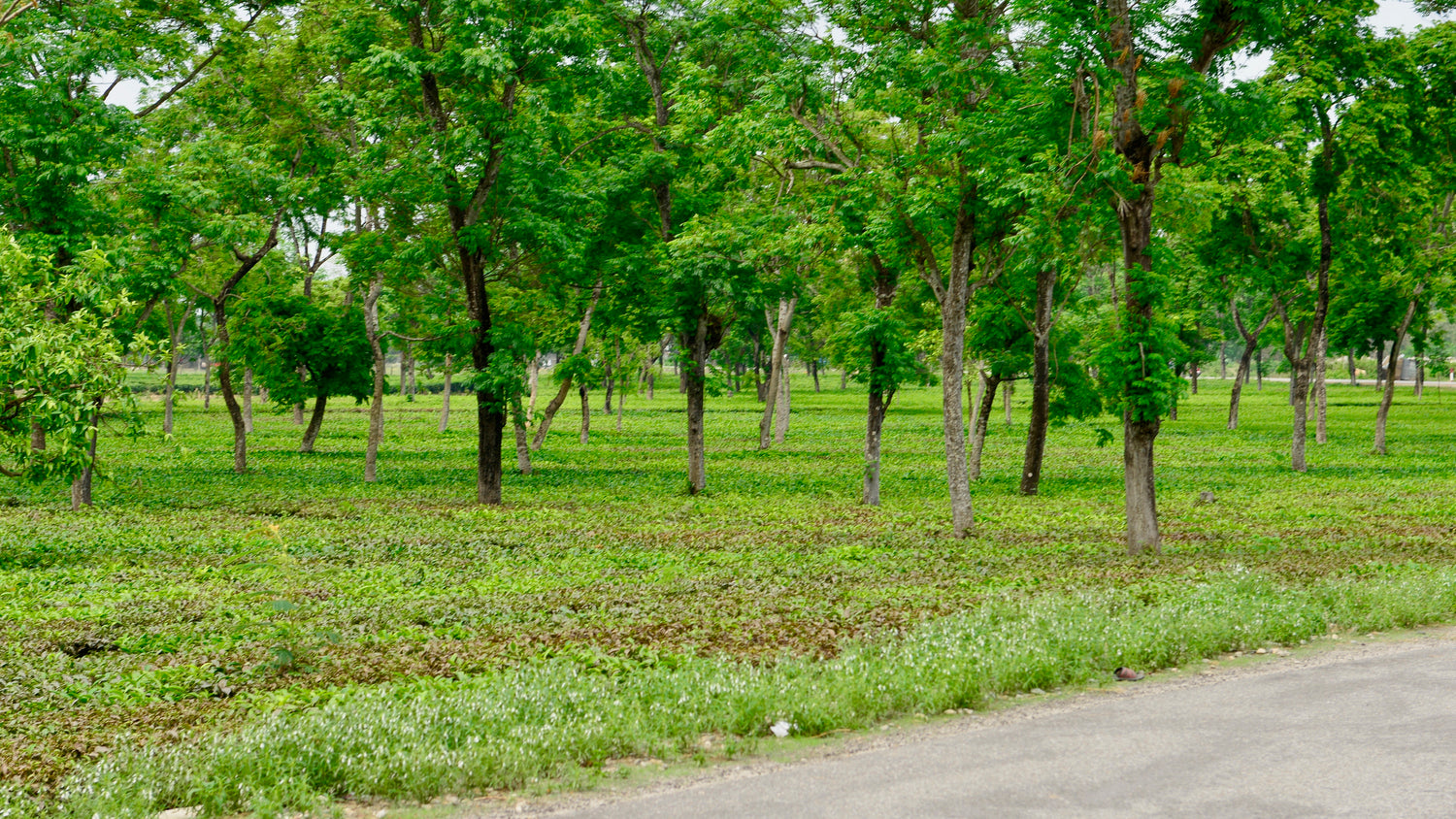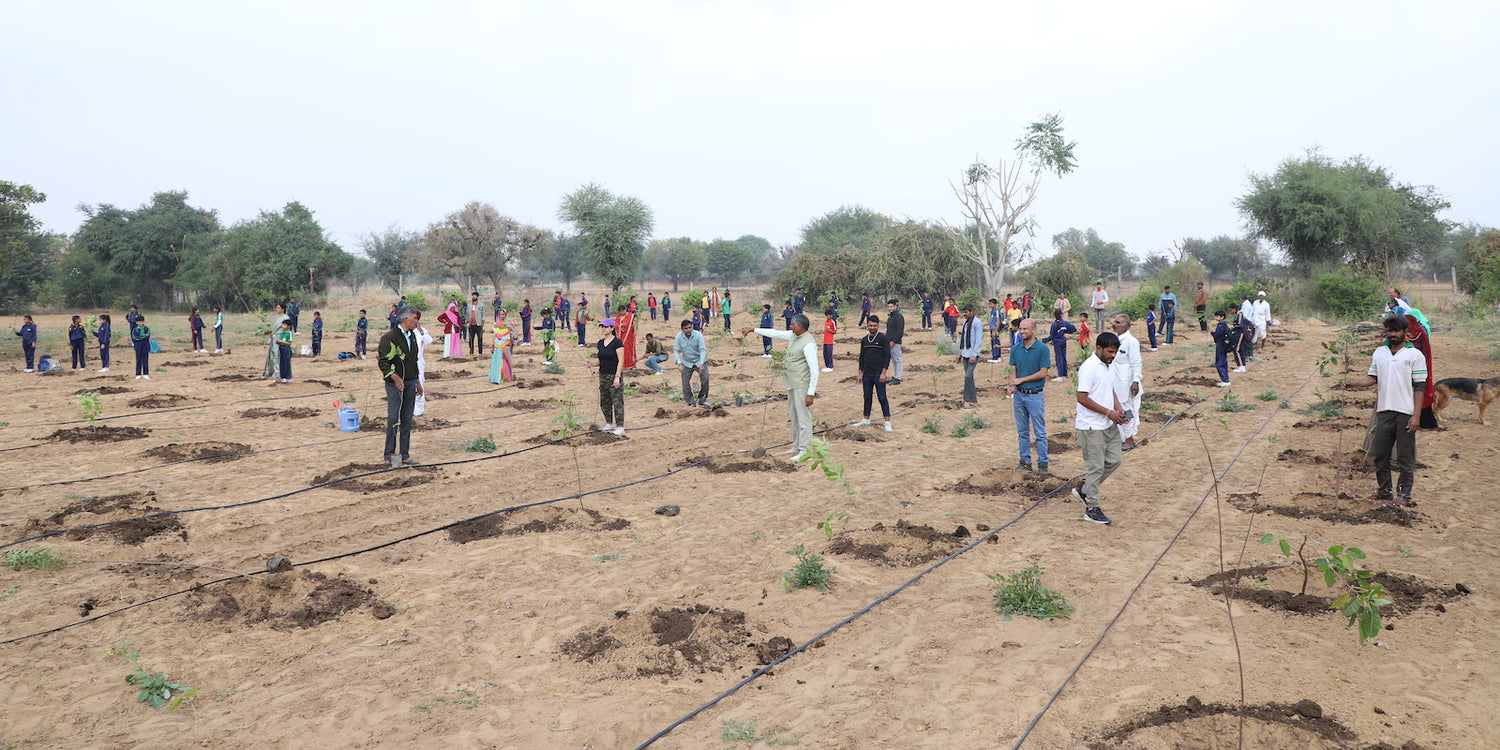Agroforestry in Odisha: A Coastal Solution for Resilient Farming
Odisha, with its extensive coastline, lush plains, and hilly terrains, is a land of agricultural vibrance and environmental challenges. The state face Read more
Connect with us
-
👥 Corporates
If you are looking for:
- 🌲 Tree Plantation Events
- 📊 CSR Projects
📧 corporate@growbilliontrees.com
📞 +91 9699723523
💬 +91 9325931304 WhatsApp (Only)
🕒 Mon - Sat | 10am - 7pm IST
-
🧩 Tree Plantation NGOs
If you are looking for:
- 💰 Financial Assistance
- 🤝 Operational Support
📧 support@growbilliontrees.com
📞 +91 9699723523
💬 +91 9325931304 WhatsApp (Only)
🕒 Mon - Sat | 10am - 7pm IST
-
🌼 Individuals
If you are looking for:
- 👥 Group Tree Plantation Drive
- 🌳 Bulk Tree Plantation
📞 +91 9699723523
💬 +91 9325931304 WhatsApp (Only)
🕒 Mon - Sat | 10am - 7pm IST
Trending
Trees for Corporates
Agroforestry in Odisha: A Coastal Solution for Resilient Farming
Odisha, with its extensive coastline, lush plains, and hilly terrains, is a land of agricultural vibrance and environmental challenges.
The state faces recurring issues like cyclones, soil erosion, deforestation, and rural poverty. In this context, agroforestry emerges as a transformative solution.
By integrating trees, crops, and livestock, agroforestry not only restores ecological balance but also enhances resilience and income for farmers.
This article explores the role of agroforestry in Odisha, its benefits, historical relevance, and how Grow Billion Trees partners with farmers and communities to implement this sustainable practice.
Historical Context of Agroforestry in Odisha
Historically, Odisha’s agrarian communities practiced tree-crop integration to support food security, fodder, and forest-based products.
Ancient farming practices included the planting of trees like Neem, Banyan, and Bamboo alongside paddy fields. In hilly regions, tribal communities relied on agroforestry for medicinal plants, fruits, and timber.
The Kendu leaf trade and cultivation of fruit-bearing trees like Mango and Jackfruit further showcased the importance of trees in Odisha’s agrarian economy.
However, post-independence, deforestation and the spread of monoculture farming weakened the integration of trees in agriculture. Today, agroforestry is being revived to tackle Odisha’s environmental challenges and promote sustainable farming.
The Need for Agroforestry in Odisha
1. Cyclone Resilience
Odisha’s coastal regions frequently face cyclones that damage crops and erode soil. Agroforestry provides windbreaks, stabilizes soil, and reduces the impact of these extreme events.
2. Restoring Degraded Lands
Deforestation and intensive farming have degraded large areas of land in Odisha. Agroforestry restores soil fertility and productivity through organic matter and root systems.
3. Enhancing Livelihoods
With small landholdings, Odisha’s farmers can diversify incomes by planting fruit, timber, and non-timber trees alongside traditional crops.
4. Addressing Water Scarcity
Agroforestry enhances groundwater recharge, reduces runoff, and conserves water in regions experiencing erratic rainfall.
5. Biodiversity Conservation
Agroforestry creates mini-forests on farmland, supporting local flora, fauna, and pollinators essential for ecosystem balance.
Scientific Benefits of Agroforestry
- Soil Health Improvement: Trees like Casuarina and Neem enrich the soil with organic matter, preventing erosion and increasing productivity.
- Carbon Sequestration: Agroforestry systems in Odisha can sequester 20–30 tons of carbon dioxide per hectare annually, mitigating climate change impacts.
- Microclimate Regulation: Tree canopies create microclimates, reducing temperature extremes and protecting crops from heat stress.
Common Agroforestry Practices in Odisha
1. Casuarina-Based Agroforestry
Casuarina trees are widely planted along Odisha’s coast to act as natural windbreaks and protect against soil erosion during cyclones. They also provide timber and fuelwood for local communities.
2. Horti-Silviculture Systems
Fruit trees like Mango, Jackfruit, and Guava are intercropped with paddy and pulses, ensuring year-round income and nutrition.
3. Silvo-Pastoral Systems
In hilly regions, trees are integrated with grasses to provide shade and fodder for livestock while stabilizing slopes and reducing soil erosion.
4. Boundary Plantations
Trees like Bamboo and Neem are planted along field edges, providing additional income from timber and serving as protective barriers for crops.
5. Mangrove Agroforestry
In coastal regions, mangroves are integrated with paddy cultivation to prevent saline intrusion and support sustainable fishing and farming.
Fun Facts About Agroforestry in Odisha
- Casuarina Coastline: Casuarina plantations have been a staple in Odisha’s coastal defense, reducing the impact of cyclones and supporting timber industries.
- Mango Hub: Odisha produces over 500,000 tons of mango annually, with agroforestry enhancing its cultivation in the state.
- Bamboo Revolution: Known as the "poor man’s timber," bamboo thrives in Odisha, offering farmers quick-growing profits and eco-friendly resources.
Environmental Impact of Agroforestry in Odisha
1. Cyclone Mitigation
Agroforestry systems with Casuarina and mangroves act as natural shields, reducing wind speed and soil erosion during cyclones like Fani and Hudhud.
2. Preventing Soil Erosion
Tree roots bind the soil, preventing erosion in coastal and hilly regions while improving the overall structure of the land.
3. Flood Management
Agroforestry enhances water infiltration and reduces runoff, mitigating flood risks in low-lying deltaic regions.
4. Enhancing Biodiversity
Agroforestry systems create habitats for birds, pollinators, and native species, contributing to biodiversity conservation.
Challenges in Agroforestry Adoption
-
Lack of Awareness Many farmers remain unaware of the benefits and profitability of agroforestry, limiting its adoption.
-
Small Landholdings Fragmented and small farms make large-scale agroforestry systems difficult to implement.
-
Market Access Farmers face challenges in accessing markets for timber and non-timber products, impacting their profitability.
-
Cyclone Vulnerability Frequent extreme weather events pose challenges for maintaining agroforestry systems in vulnerable coastal areas.
Grow Billion Trees: Transforming Odisha with Agroforestry
Grow Billion Trees plays a critical role in promoting agroforestry in Odisha by empowering farmers, restoring ecosystems, and mitigating climate challenges.
Collaborations
- Partnering with local communities, NGOs, and government bodies like the Odisha Forest Department to implement agroforestry projects.
- Collaborating with agricultural research institutions to develop region-specific agroforestry models for coastal and inland regions.
Execution Strategies
- Tree Nurseries: Establishing nurseries to supply saplings of species like Casuarina, Neem, Bamboo, and Mango at subsidized rates.
- Farmer Training Programs: Organizing workshops and field demonstrations to educate farmers about agroforestry practices and their benefits.
- Coastal Restoration Projects: Planting mangroves and Casuarina along Odisha’s vulnerable coastline to combat cyclone damage and stabilize soil.
Awareness and Advocacy
- Running awareness campaigns to highlight agroforestry’s role in protecting the environment and enhancing farmer incomes.
- Sharing success stories of farmers who have adopted agroforestry to inspire others to embrace the practice.
Key Achievements by Grow Billion Trees
- Tree Plantation Drives: Over 7 million trees planted across Odisha, increasing green cover and restoring degraded lands.
- Coastal Protection: Implemented large-scale Casuarina and mangrove plantations to protect vulnerable coastlines and farmlands.
- Farmer Empowerment: Trained 15,000+ farmers to adopt agroforestry, improving their incomes by up to 35%.
- Carbon Sequestration: Agroforestry projects in Odisha have sequestered over 800,000 tons of carbon dioxide, contributing to climate resilience.
Future Prospects
By 2030, agroforestry in Odisha has the potential to:
- Increase the state’s green cover by 20%, aligning with India’s national reforestation goals.
- Restore over 1 million hectares of degraded land, ensuring sustainable agriculture and food security.
- Provide additional income to over 50,000 farming households, improving rural economic resilience.
- Mitigate the impacts of cyclones and climate change by enhancing coastal ecosystems with tree-based systems.
Conclusion
Agroforestry in Odisha is a beacon of hope for sustainable agriculture and resilient ecosystems.
By combining trees with crops and livestock, it addresses critical challenges like soil degradation, water scarcity, and vulnerability to cyclones. Agroforestry not only enhances biodiversity and mitigates climate change but also provides economic stability to Odisha’s farmers.
Grow Billion Trees is leading the way, working tirelessly to implement agroforestry solutions that restore ecosystems, empower farmers, and protect vulnerable coastal regions. Together, agroforestry can transform Odisha’s agricultural landscape, ensuring a greener, more resilient, and prosperous future for generations to come.
Casuarina Agroforestry in Odisha
Casuarina trees are Odisha’s frontline warriors against cyclones, acting as windbreaks while providing timber and protecting coastal farmlands from erosion.
Mangrove-Based Agroforestry
Mangroves are coastal superheroes, stabilizing soil, protecting against saline intrusion, and offering livelihoods through sustainable fishing and honey production.
Bamboo Agroforestry in Odisha
Fast-growing and versatile, bamboo thrives in Odisha’s landscape, serving as construction material, handicraft resource, and a sustainable income booster for farmers.
Neem in Agroforestry Systems
The Neem tree improves soil health, provides natural pest control, and doubles as a medicinal marvel, making it a must-have for resilient agroforestry systems.
Horti-Silviculture in Odisha
Combining fruit trees like mango, jackfruit, and guava with timber species, this system enhances farmer incomes while ensuring year-round produce.
Silvo-Pastoral Agroforestry
Trees and grasses together provide shade and fodder for livestock, stabilizing soil in flood-prone and hilly regions across Odisha.
Jackfruit Agroforestry Systems
Jackfruit trees thrive in Odisha, offering nutritious fruits, fodder, and timber, making them a delicious and profitable part of agroforestry landscapes.
Agroforestry for Cyclone Mitigation
Tree-based systems like Casuarina and mangroves shield coastal farms from cyclone damage, offering Odisha a natural solution to recurring storms.
Boundary Plantations in Odisha
Planting Neem, Karanja, and Bamboo along field edges protects crops, reduces wind impact, and provides farmers with timber and additional income.
Agroforestry for Soil Restoration
Trees improve soil structure and organic content, reversing the damage caused by intensive farming and coastal erosion across Odisha’s farmlands.
Agroforestry and Water Conservation in Odisha
Tree roots enhance groundwater recharge, reduce runoff, and ensure sustainable water management in Odisha’s agriculture-driven regions.
Grow Billion Trees in Odisha Agroforestry
By supplying saplings, training farmers, and restoring degraded lands, Grow Billion Trees is championing agroforestry to boost Odisha’s farming resilience.
You may like
Corporate Plantations
FAQ
What is agroforestry in Odisha?
Agroforestry integrates trees with crops and livestock to boost farm productivity and resilience. Grow Billion Trees promotes this practice to protect Odisha’s coastal regions and empower farmers.
Why is agroforestry important for Odisha’s coastal areas?
Agroforestry shields farmlands from cyclones, prevents soil erosion, and supports sustainable incomes. Grow Billion Trees encourages tree-based systems like mangroves and Casuarina plantations for coastal resilience.
How do Casuarina trees help Odisha’s farmers?
Casuarina trees act as natural windbreaks, protect farms from cyclones, and provide high-value timber. Grow Billion Trees supplies saplings and training to implement Casuarina-based agroforestry.
What role do mangroves play in Odisha’s agroforestry?
Mangroves stabilize coastlines, prevent saline intrusion, and offer economic benefits like fishing and honey production. Grow Billion Trees promotes mangrove restoration for sustainable coastal farming.
Which trees are popular in Odisha’s agroforestry systems?
Casuarina, Bamboo, Neem, and Jackfruit thrive in Odisha’s landscapes, offering timber, fruits, and ecological benefits. Grow Billion Trees helps farmers access these resilient tree species.
How does agroforestry restore degraded lands in Odisha?
Trees improve soil fertility, stabilize erosion-prone areas, and reverse land degradation. Grow Billion Trees supports farmers with saplings and agroforestry models suited for Odisha’s needs.
Can agroforestry reduce cyclone impacts in Odisha?
Yes, agroforestry systems like Casuarina and mangrove plantations act as natural barriers, reducing wind speed and protecting farms. Grow Billion Trees implements these systems across cyclone-prone regions.
How does agroforestry enhance biodiversity in Odisha?
Agroforestry creates habitats for birds, pollinators, and marine life, turning farms into biodiversity hotspots. Grow Billion Trees designs agroforestry systems that support Odisha’s rich ecosystems.
How does bamboo agroforestry benefit Odisha’s farmers?
Bamboo grows fast, supports rural industries, and provides timber and fodder. Grow Billion Trees promotes bamboo agroforestry to improve incomes and restore degraded lands.
What is silvo-pastoral agroforestry, and how does it help Odisha?
This system combines trees and grasses to provide livestock fodder while stabilizing soil. Grow Billion Trees encourages silvo-pastoral systems in Odisha’s hilly and flood-prone areas.
How does agroforestry address water scarcity in Odisha?
Tree roots reduce runoff, recharge groundwater, and improve water retention, ensuring sustainable irrigation. Grow Billion Trees promotes agroforestry as a water-smart solution for Odisha’s farmers.
How is Grow Billion Trees supporting agroforestry in Odisha?
We provide saplings, train farmers, and restore ecosystems with tree-based solutions, ensuring agroforestry strengthens Odisha’s farming resilience and coastal protection.























